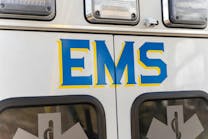You arrive for a difficulty-breathing emergency. The patient is alert and oriented and complaining of difficulty breathing. The patient appears to be mildly distressed and slightly anxious, but vitals are within normal limits. Pulse oximetry is 98 percent. The patient shows no signs of significant respiratory distress nor other medical emergencies. Is the patient genuinely exchanging gasses at a cellular level?
First responders must understand the differences between breathing and respiration. Just because someone appears to be breathing doesn’t mean that the individual’s cells are receiving oxygen and getting rid of carbon dioxide. Understanding the gas exchange process is essential and will assist your treatment modality.
Breathing vs. respiration
Breathing and respiration are completely different but interrelated body processes that assist the body’s organs to function appropriately. Breathing is the physical process of exchanging gases; respiration is a chemical process that occurs at a cellular level and produces energy.
Breathing starts when you inhale air and the air enters the lungs. Normal breathing is accomplished almost entirely by the movement of the diaphragm. Inhalation is an active phase that requires energy and usually takes 1–1½ seconds. Exhalation is passive, which generally is twice the duration of inhalation. The entire process takes about 5 seconds. The good thing is that if your patient inhales, air usually will come out. As first responders, air will come out if you get it in.
Tidal volume is the amount of air that moves in and out of the lungs with each breath. This amount is about 500 milliliters for an adult male and 400 milliliters for an adult female. Respiratory minute volume (or minute ventilation, or VE) is tidal volume times the number of respirations. Most first responders forget that there are about 150 milliliters of dead space air, which is the amount of air that occupies the space from the tip of the nose to the alveoli. (Alveoli move but aren’t used in gas exchange.) Restrictive pulmonary disease patients who have pulmonary fibrosis or pneumothorax have decreased tidal volumes. The tidal volume of people who have obstructive diseases, including asthma and emphysema, is about the same, but flow rates are impeded.
There also is the matter of V/Q mismatch, where gases can’t exchange between the alveoli and the circulatory system. Examples include an obstructed airway, such as when a victim is choking, and an occluded blood vessel, as in a blood clot in the lung. V/Q mismatch also can happen when a medical condition prevents people from extracting oxygen when they bring in the air or when people don’t pick up oxygen when they bring in blood, such as with carbon monoxide poisoning.
Respiration is the process of gas exchange between the air and body tissues and cells. The three types of respiration are external, internal and cellular. External respiration is the actual breathing process; it involves inhaling and exhalation of gasses. Internal respiration involves gas exchange between the blood and body cells. Cellular respiration consists of the conversion of food to energy. Cellular respiration is broken into aerobic respiration and anaerobic respiration. Aerobic respiration requires oxygen and glucose; anaerobic respiration only requires glucose.
First responders must determine their patient’s successfulness at breathing and the amount of gas exchange occurring. Just because patients seem as though they are breathing doesn’t mean that they have proficient cellular respiration. If cellular respiration becomes nonfunctional, the body will do two things: go into anaerobic metabolism and decrease energy production. Both are detrimental to patients and their survivability.
Abnormal cellular respiration
Signs of abnormal cellular respiration in adult patients can include signs or symptoms of anxiety or restlessness; a lack of alertness; and a lack of being oriented to person, place, time and situation (X4). Heart rate and respiratory rates can be fast, slow or irregular. Patients might have difficulty breathing or difficulty with usage of accessory muscles. They might be in a full Fowler’s position or tripoding. Their skin color might be pale, cyanotic or ashen gray.
In children and infants, you also can find nasal flaring, less activity or an appearance of lifelessness or tripoding. History of respiratory illness also can also hinder normal cellular respiration. These all might be subtle and difficult to assess.
It all boils down to understanding the pulmonary/circulatory relationship and function, so you can better understand whether your patient is perfusing and exchanging oxygen/carbon dioxide typically.
Does your patient need assistance in ventilating? Does your patient need to be given low or high flow oxygen?
A good rule to keep in mind: An adult who is breathing fewer than 10 times per minute or more than 20 times per minute is concerning.
Most protocols on giving oxygen work with a pulse oximetry of less than 95 percent. That said, remember, carbon monoxide poisoning will provide a false positive of 100 percent.
The best sign of adequate cellular respiration is the patient’s mental status. The first sign of hypoxia, whatever the reason, is anxiety and restlessness.
Never hold back oxygen or ventilation. Always treat your patient, not your monitors.

Richard Bossert
Richard Bossert is a retired operations chief for the Philadelphia Fire Department. He started in the fire/rescue services in 1970, volunteering for the Warminster, PA, Fire Department. He worked for three career fire departments: Chester, Bensalem and Philadelphia. Bossert became a certified EMT in 1973, then paramedic in 1980. He received a bachelor’s degree in pre-med from Pennsylvania State University in 1977 and a master’s degree in public safety administration from St. Joseph’s University in 2003.






